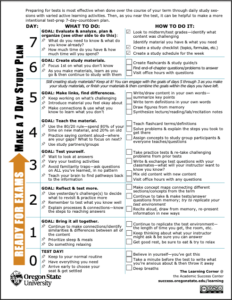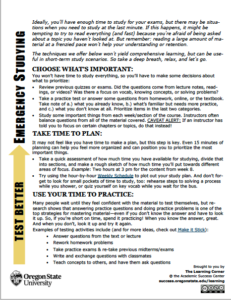Motivation has been a common topic of conversation the last year and a half, and understandably so. Many students felt less motivated learning remotely and that their motivation would return once they were back in-person. However, it may not be that simple. A student may feel motivated to complete course work but may find it difficult to study for exams; they may find it easy to motivate themselves to connect with peers but find it challenging to connect with instructors. Given motivation is complex and contextual, I wanted to provide an overview of how we in the Academic Success Center (ASC) talk about motivation with students and share tools you can use to support students.
Encourage Self-Awareness
I hear many students talk about motivation as something that is out of their control. They see it as something they have to wait for, or they see it as a fixed trait; they are either someone who is easily motivated, or they’re not. When talking with students, I encourage them to see motivation as a skill that can be better understood and improved. Understanding themselves and how they respond to the task they need to complete can help them tap into strategies for getting work done. As with many of the skills we chat about at the ASC, developing successful motivation techniques take time and practice.
Everyone is different and what works for one person may not work for another. Given motivation can shift depending on the context and task, it may help to start a conversation with the following questions when helping students develop self-awareness around their motivation:
- What about this task feels challenging? Does it feel too large? Do they need resources? Are they uninterested in the subject? Knowing what feels challenging can help you ask better follow-up questions.
- When you’ve felt unmotivated in the past, what has helped you start working on things? Tapping into previous strategies can help students realize they are capable of getting work done.
- How could you reward yourself for finishing this task? Sometimes having something to look forward to can provide incentive.
You can also support them by introducing ASC worksheets. After your initial conversation, you could introduce Motivation Techniques and ask them what they think could work for them, depending on the situation.
To help with developing self-awareness, you could share the 6 Reasons People Procrastinate. This could be especially helpful for students who aren’t sure why they aren’t feeling motivated and want to read more about the research behind procrastination.
Help Students Identify What They Can Control
One important note is that motivation often depends on our environment. We each face countless distractions in our work spaces – our phones, friends or family, that Netflix show we would rather be binging. One strategy for motivation can be setting up an environment that feels more productive. As you’re working with students, consider asking them some of the following questions:
- Where do you do your best work?
- Is there anything you can do to make your environment more productive?
- How long can you typically focus before you need to take a break?
Besides adjusting their environment, students can also control the way they break down tasks and how they use their time. Students may have a hard time starting a task if it feels overwhelming or if they don’t have much time. One strategy we discuss with students is the “ten-minute rule.” We recommend students tell themselves, “I’m just going to work on this for ten minutes.” Once a task is started, people often keep going – motivation builds as we work on things, rather than striking like lightning. If they only have ten minutes, they’ve still gotten something done which could motivate them to keep chipping away at the task later.
Let Them Know They’re Not Alone
As I mentioned before, we talk to students about motivation a lot. They may feel like everyone else is able to get stuff done while they struggle, but they are definitely not alone in the challenge of motivation.
As you support students, consider sharing your own stories and techniques, while also noting that the strategies that work for you may be different from what works for them, and this is ok. Being able to normalize different approaches and validate their ability to seek support is so important.
In addition, sometimes talking to fellow students about motivation can be a helpful step. Students can drop by the Academic Success Center in Waldo 125 M-F 9 AM to 5 PM to talk with an ASC Strategists. Strategists are also available via live chat on our website and via email, phone, or text message.
I know how challenging it can be to talk about motivation, and I hope these tools and strategies are helpful as you support students.








